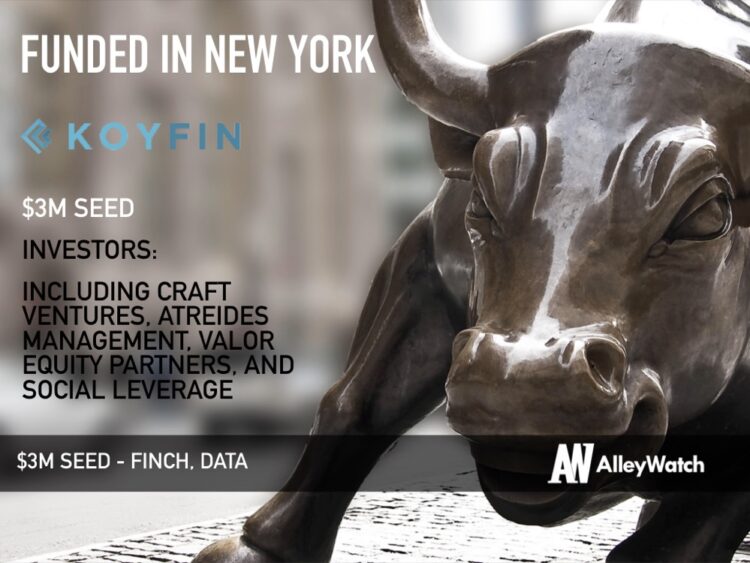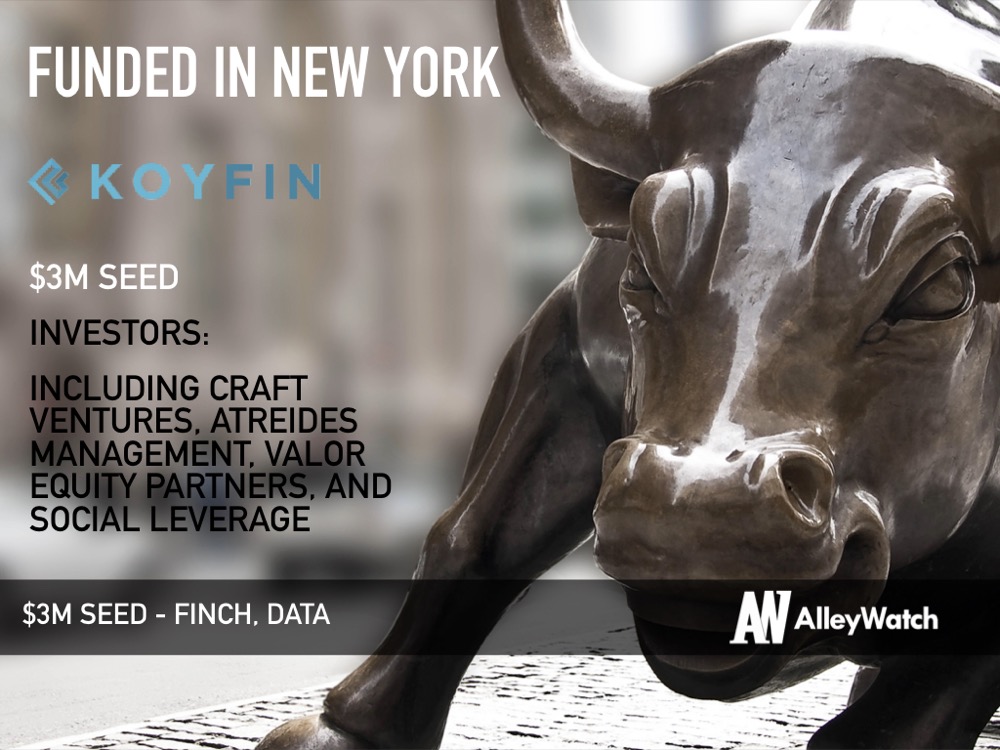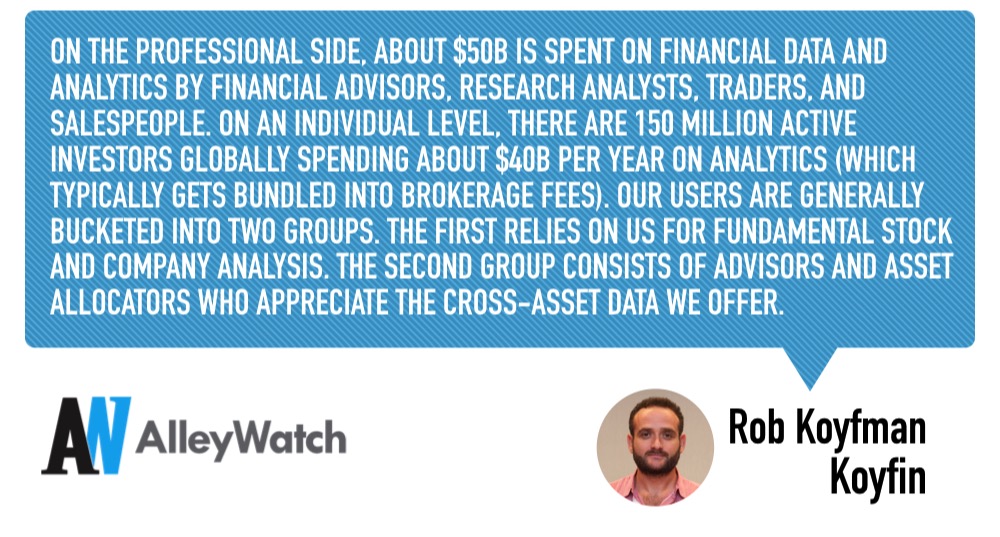The Bloomberg Terminal has been the go-to analytics and financial research platform for finance professionals, with over 325,000 professionals but it comes with a hefty price tag; $25K+ per user per year. This steep upfront cost becomes cost-prohibitive for a large portion of the investment community. Koyfin has built a freemium financial data and analytics platform that gives investors unparalleled insight into the market by providing data coverage ranging from the essentials like stocks & ETFs to social media. This incoming stream of total market coverage data can easily be transformed into actionable insights through Koyfin’s built-in charting and dashboarding tools, thus alleviating the need to download and import data into Excel. With over 10,000 active users on Koyfin, the company launched in 2016 has been able to offer a robust solution that comes at a fraction of the cost of the other options in the marketplace.
AlleyWatch sat down with CEO and Founder Rob Koyfman to learn more about his own experience with financial investment research led to the creation of Koyfin, the company’s future plans, and recent round of funding.
Who were your investors and how much did you raise?
We just raised a $3M Series Seed from Craft Ventures, Atreides Management, and Valor Equity Partners. Social Leverage and several existing investors also participated.
Tell us about the product or service that Koyfin offers.
Koyfin is a financial data and analytics platform for researching stocks and understanding market trends. We provide broad data coverage that includes stocks, ETFs, mutual funds, FX, bonds, economics, news, and Twitter so you can have a god-like view of the markets. We built all of our charting and dashboard tools from scratch to give our users the ultimate functionality to turn data into information. Koyfin is free, so go and try it!
 What inspired you to start Koyfin?
What inspired you to start Koyfin?
I spent 15 years on Wall Street in various roles including equity research, macro strategy, and ETF trading. I always had access to professional analytical platforms such as Bloomberg, Reuters, and Factset, and my job was primarily to find and analyze investment ideas. In 2016, I left a hedge fund and started trading on my own. It was the first time I had to pay for data and systems myself. The thought of forking over $25K for a Bloomberg gave me anxiety, so I started looking at alternatives that were more affordable. I quickly learned that the market was bifurcated with professional systems costing more than most investors could afford, and other resources like financial websites and brokerages that were too basic and didn’t provide the necessary data or functionality. I thought I had the right background to solve this problem, so I decided to give it a shot.
How is Koyfin different?
We have about 10,000 active users and here’s what they tell us: First, we’re a one-stop-shop for investors needing total market coverage. We provide professional-grade data beyond stock prices, including company financials, analyst estimates, filings, and news. And we cover other assets like ETFs, Bond Yields, and Economics for a complete view of the market. Second, we offer the tools and analytics to turn data into information. Instead of encouraging you to download the data into Excel like many other platforms, we built our charting and dashboarding tools from scratch so you can skip Excel and instead make and annotate beautiful charts much more easily right in our web application. Third, we have an obsessive focus on design and creating a delightful user experience.
What market does Koyfin target and how big is it?
We have a prosumer focus and our current user base is evenly split between professional investors and individuals. On the professional side, about $50B is spent on financial data and analytics by financial advisors, research analysts, traders, and salespeople. On an individual level, there are 150 million active investors globally spending about $40B per year on analytics (which typically gets bundled into brokerage fees). Our users are generally bucketed into two groups. The first relies on us for fundamental stock and company analysis. The second group consists of advisors and asset allocators who appreciate the cross-asset data we offer.
Who do you consider to be your primary competitors?
Our main competitors are mass-market sites like Yahoo Finance and Google Finance. On the professional side, many of our users have to share a Bloomberg terminal, and Koyfin gives them the functionality they need instead of walking across the floor to a shared terminal. Other companies in our space are Money.net, Sentieo, and Ycharts.
What’s your business model?
Koyfin is currently totally free, and in the future, we’ll shift to a freemium business model. The paid tiers will offer more data, advanced functionality, and personalization.
What was the funding process like?
We’re in an interesting position raising a seed round with a pretty well-developed product and strong user base. We were lucky to find investors who use our product and closed the round in about 6 weeks start to finish. Prior to this round, we found it challenging to raise money as first-time founders without a product. The current round was oversubscribed, and we had a lot of inbound interest.
What are the biggest challenges that you faced while raising capital?
My cofounder and I bootstrapped the company for 2 years before any funding. However, as the product came together, we had user traction and VCs became more comfortable that we can execute on our vision. The current round is led by investors who love our product and use it in their jobs. The biggest lesson we’ve learned is that there are so many different VCs and it’s important to find ones that understand the opportunity we’re working on. A lot of investors we met were like, “great, another Bloomberg killer” even though that’s not our focus. It’s important to find investors you click with and who understand your vision.
The biggest lesson we’ve learned is that there are so many different VCs and it’s important to find ones that understand the opportunity we’re working on. A lot of investors we met were like, “great, another Bloomberg killer” even though that’s not our focus. It’s important to find investors you click with and who understand your vision.
What factors about your business led your investors to write the check?
Finance is one of the few verticals where there hasn’t been any consumerization of enterprise products and that’s what we’re doing. Companies like Superhuman, Dropbox and Zoom have gained traction in enterprise from the bottom up. This strategy has never been tried in finance and it’s working for us because we have an amazing product that’s powerful and easy to use.
What are the milestones you plan to achieve in the next six months?
The main focus is on expanding the functionality of our product and growing our user base. On functionality, we plan to have global equity coverage and additional features like portfolio analytics and screening. Our goal is to double the number of active users to 20K in the next six months.
What advice can you offer companies in New York that do not have a fresh injection of capital in the bank?
Focus on a small, narrowly defined problem and show that you are solving this problem for users. Too many companies start thinking about growth before finding product-market fit. Also, get to know the founders of companies who are in your space and have been doing it longer than you. These founders will know the active investors that might be interested. Take advantage of the NY startup ecosystem. I went to every single meetup I could find in the fintech and technology space. The food and beer are terrible, but you can make great connections.
Where do you see the company going now over the near term?
We are expanding our engineering team in NY to increase the velocity of our product development. We’re also looking for marketing roles to help us grow our user base. If you’re interested in these roles, reach out!
What’s your favorite restaurant in the city?
I recently went to Rezdora with my wife and it was phenomenal.





